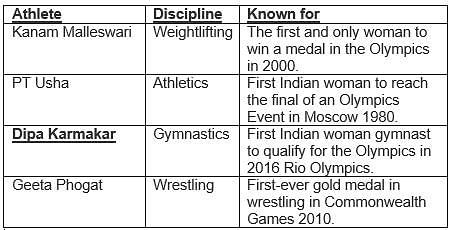Defence Exam > Defence Questions > Who is the first Indian woman gymnast to qual...
Start Learning for Free
Who is the first Indian woman gymnast to qualify for the Olympics?
- a)Karnam Malleswari
- b)P.T. Usha
- c)Dipa Karmakar
- d)Geeta Phogat
Correct answer is option 'C'. Can you explain this answer?
| FREE This question is part of | Download PDF Attempt this Test |
Verified Answer
Who is the first Indian woman gymnast to qualify for the Olympics?a)Ka...


|
Explore Courses for Defence exam
|

|
Similar Defence Doubts
Who is the first Indian woman gymnast to qualify for the Olympics?a)Karnam Malleswarib)P.T. Ushac)Dipa Karmakard)Geeta PhogatCorrect answer is option 'C'. Can you explain this answer?
Question Description
Who is the first Indian woman gymnast to qualify for the Olympics?a)Karnam Malleswarib)P.T. Ushac)Dipa Karmakard)Geeta PhogatCorrect answer is option 'C'. Can you explain this answer? for Defence 2024 is part of Defence preparation. The Question and answers have been prepared according to the Defence exam syllabus. Information about Who is the first Indian woman gymnast to qualify for the Olympics?a)Karnam Malleswarib)P.T. Ushac)Dipa Karmakard)Geeta PhogatCorrect answer is option 'C'. Can you explain this answer? covers all topics & solutions for Defence 2024 Exam. Find important definitions, questions, meanings, examples, exercises and tests below for Who is the first Indian woman gymnast to qualify for the Olympics?a)Karnam Malleswarib)P.T. Ushac)Dipa Karmakard)Geeta PhogatCorrect answer is option 'C'. Can you explain this answer?.
Who is the first Indian woman gymnast to qualify for the Olympics?a)Karnam Malleswarib)P.T. Ushac)Dipa Karmakard)Geeta PhogatCorrect answer is option 'C'. Can you explain this answer? for Defence 2024 is part of Defence preparation. The Question and answers have been prepared according to the Defence exam syllabus. Information about Who is the first Indian woman gymnast to qualify for the Olympics?a)Karnam Malleswarib)P.T. Ushac)Dipa Karmakard)Geeta PhogatCorrect answer is option 'C'. Can you explain this answer? covers all topics & solutions for Defence 2024 Exam. Find important definitions, questions, meanings, examples, exercises and tests below for Who is the first Indian woman gymnast to qualify for the Olympics?a)Karnam Malleswarib)P.T. Ushac)Dipa Karmakard)Geeta PhogatCorrect answer is option 'C'. Can you explain this answer?.
Solutions for Who is the first Indian woman gymnast to qualify for the Olympics?a)Karnam Malleswarib)P.T. Ushac)Dipa Karmakard)Geeta PhogatCorrect answer is option 'C'. Can you explain this answer? in English & in Hindi are available as part of our courses for Defence.
Download more important topics, notes, lectures and mock test series for Defence Exam by signing up for free.
Here you can find the meaning of Who is the first Indian woman gymnast to qualify for the Olympics?a)Karnam Malleswarib)P.T. Ushac)Dipa Karmakard)Geeta PhogatCorrect answer is option 'C'. Can you explain this answer? defined & explained in the simplest way possible. Besides giving the explanation of
Who is the first Indian woman gymnast to qualify for the Olympics?a)Karnam Malleswarib)P.T. Ushac)Dipa Karmakard)Geeta PhogatCorrect answer is option 'C'. Can you explain this answer?, a detailed solution for Who is the first Indian woman gymnast to qualify for the Olympics?a)Karnam Malleswarib)P.T. Ushac)Dipa Karmakard)Geeta PhogatCorrect answer is option 'C'. Can you explain this answer? has been provided alongside types of Who is the first Indian woman gymnast to qualify for the Olympics?a)Karnam Malleswarib)P.T. Ushac)Dipa Karmakard)Geeta PhogatCorrect answer is option 'C'. Can you explain this answer? theory, EduRev gives you an
ample number of questions to practice Who is the first Indian woman gymnast to qualify for the Olympics?a)Karnam Malleswarib)P.T. Ushac)Dipa Karmakard)Geeta PhogatCorrect answer is option 'C'. Can you explain this answer? tests, examples and also practice Defence tests.

|
Explore Courses for Defence exam
|

|
Signup for Free!
Signup to see your scores go up within 7 days! Learn & Practice with 1000+ FREE Notes, Videos & Tests.


















